The Weathercock Inn, Aspley Guise
The Weathercock stands at the junction of Station Road and Weathercock Lane, on the Bedfordshire side of the border (but only just!) actually in the parish of Aspley Guise.
Of course, Station Road has only had that name since the railway station arrived in 1846 and to confuse things further, Weathercock Lane was usually called Aspley Road up until about 1935. Also, before the railway came, Cranfield Road used to carry on directly from the sharp corner by the side of the Recreation Ground and meet Station Road near the Weathercock. It was turned to run along the tracks to where it meets Newport Road now to avoid having to build two road crossings so close together when the railway was built.
The late Arthur Parker researched the history of this inn in the 1970’s. The work below began as his notes, but I have added in many newspaper stories and other facts as I have found them. I only saw one story related to it in all the “Woburn Reporters” newspapers I searched through at Bedfordshire and Luton Archives. I think it concerned a lady tramp who tried to use some stamps she had stolen from Woburn Sands Post Office as cash at the bar. I was looking for Fir Tree Inn news articles at that time and regret I did not make notes about the incident, but I think it was sometime around the 1930’s. The paper stated that it was the first event about the Weathercock Inn that had made the news that anyone could remember!
The images used here come from my own collection and that of the Woburn Sands District Society.
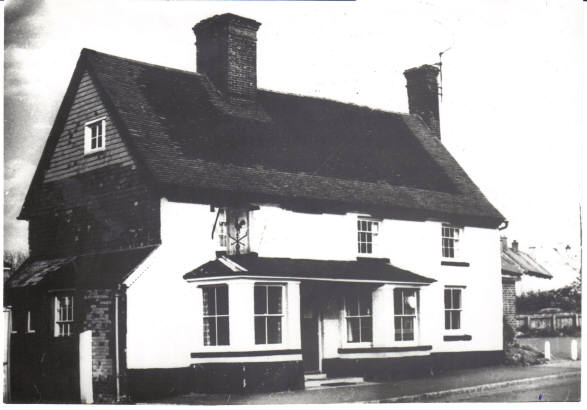
Arthur Parker:- “One naturally expects to find public houses in the centres of habitation, but what would one expect in a place like Hogsty End, where, in 1740, it is recorded there were 12 houses and not many more than another 30 scattered over the Heath to Longslade.
For a sprawling 40 houses, two or three inns seem unlikely, but at the end of the eighteenth century we had four licensed houses.
It must not be overlooked that the inns of those days catered especially for the traveller – and was not Hogsty End on the turnpike road, which carried coaches from Holyhead, Chester, Manchester, Leicester, Northampton, Wellingborough and other places, on their way to London? So it is not surprising to find our first inns on this much used road. They were not big enough to serve the coaches, most of which went through to and from Woburn (which had 20 inns) and was an important posting station. Our inns most likely catered for the waggon traffic, carrying goods and the coach baggage.
The earliest record of a ‘local’ comes from old Assize accounts, which tells of drinking at Hogsty Houses, but at which inn it does not say. Not far away was the Friends Meeting House, sometimes known as Hogsty House, and this leads me to think the writer in using that term referred to the nearest inn, which was the Swan. It stood at the crossroads and was a very likely house to be used by a stranger.
The Weathercock is one of the oldest inns of Hogsty End, and may be the oldest, but why it was built in its then isolated position is hard to explain. It changed hands a few times in its early days, and from the old Hoare Estate deeds of Wavendon, one gathers the following information.
The first reference to the property is in 1662 when a lease for 999 years at a peppercorn rent was granted by Richard Newman, a carpenter of Ridgmont, to Robert Burrowes and his intended wife, Jane Ambridge, both of Aspley Guise. It is from this ownership at the name “Burrow’s Close” came to be used in the years that followed, and which has been revived to give a title to the present building estate. The property was then described as “a parcel of sward [land covered with grassy turf] ground” of 5¾ acres, in Newman’s occupation.
Unfortunately, there is a span of nearly one hundred years between the foregoing and the next deed, and this covers the transfer of much of the surrounding land, including the wind and water mills at the rear. The reference to the Weathercock says –
“Whereas there was lately built on the said parcel of sward ground a messuage with stables and other buildings now standing thereon, in the occupation of Ralph French, known as The Thatched Inn”.
The date of the deed is 10 May 1758, and it states the property is vested for the remainder of the lease in Richard How, senior, and that he transfers it to his son, Briggens. In those days new buildings were a rarity, and anything erected within the previous, say, fifty years was described as “lately built”, so the term must be construed in a very wide sense.
However, its age can be more accurately fixed from another an entry in the Wavendon Church registers, which reads:
“1708, September 9. A woman (stranger) left at the New Inn as she was going to Yorkshire to her friends; her name, Ann Wilbee; was buried”
The term “stranger” and the name “Wilbee” make interesting reading, for in the above quoted deed of 1758 the occupier of the windmill and its house and the surrounding fields was John Wilbee. Was Ann a stranger, even though the events were fifty years apart?
There was another burial mentioned in Wavendon Parish Registers, that on May 11th, 1710 of “Thomas Simcock, hostler at the New Inn, age about 20, his father lives at Newcastle Under Lyme, Staffordshire…”
There is no information as to who built the inn. It was no doubt erected to serve both as hostelry and farmstead, as there were extensive outbuildings, most of which survive, and for many years much of the surrounding land was farmed from here. One can hardly imagine Quaker How building a public house, and it is more than likely it was established by Burrows soon after he bought the land.
From an inspection of the high-pitched roof there is no doubt the building was at first thatched, but that title did not last very long. By the middle of the century it was The New Inn (another instance of fifty years of ‘new-ness’) A deed of 1759, granting the use of a nearby well refers to it as The New Inn, and the same name is used in the Aspley Guise Enclosure Award of 1761.”
Here, I can begin to add some information to Parkers original work. This snippet from the Northampton Mercury of 24th September, 1785:
“NOTICE hereby given, That a STATUTE for Hiring SERVANTS will be held at Mr. Price’s, the Weather-Cock, Hogstye-Houses, on Thursday the 29th of September. Dinner at One o’Clock.”
A servants fair wasn’t for house servents, this was for farm labourers. Labourers hired on to a farm for a year at a time. If they proved hard workers, of course, the farm would want to hire them again the next year, but if they were idle, they wouldn’t get picked.
It shows that the Weathercock name was being used ealier than Parker thought, but it seems that several names were in use at the same time. In 1785, a Mr Paterson published an atlas of road maps, one of which showed the route from Hockliffe to Manchester, passing through Hogsty End. The only inn marked is a ‘White Hart’, where the Weathercock now stands.
In the Northampton Mercury of 19th September 1789, this appeared:
“To be SOLD by AUCTION, By T. SHAW, On Monday, September the 28th, Ten o’Clock, PART of the FARMING-UTENSILS and useful HOUSEHOLD-FURNITURE, of Mr. RICHARDS, at the NEW INN, WOBURN SANDS Consisting of one Six-Inch and one Three Inch Wheel Carts, Ploughs, Harrows, four Cow-Cribs, Harness for four Horses, Sacks, and other Farming-Utensils; Bedsteads with neat Furnitures, Feather Beds, Quilts, Blankets and Counterpanes; Pier, Chimney and Dressing Tables, Chairs, Drawers, &c. a Range of Grates, Jack, a three-leaved Skreen, Pewter and Brass; Brewing and Washing Coppers, Vats, Backs, Tubs, &c. a great Quantity of Puncheons, Hogsheads, Half-Hogsheads, &c. and sundry other useful Articles.”
…but was Mr. Richards the licensee, or just a farmer having his goods sold at the Weathercock?
There are a couple of instances of the use of “The White Hart” at Woburn Sands, which can only be The Weathercock. This is the first mention of the Hatton/Hutton family, who went on to have a connection to the inn for at least 54 years. From the Northampton Mercury, 27th October 1792:
“To be SOLD, A PATENT DRILL MACHINE (by Cook), with its COMPLETE APPARATUS – has been only two Seasons, and is much approved of. The Owner now residing in London, is the Cause it’s being Sold. Apply to Mr. Hatton, the White-Hart Inn, on Woburn Sands.”
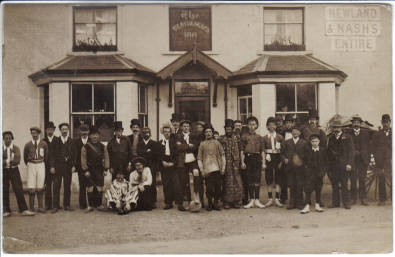
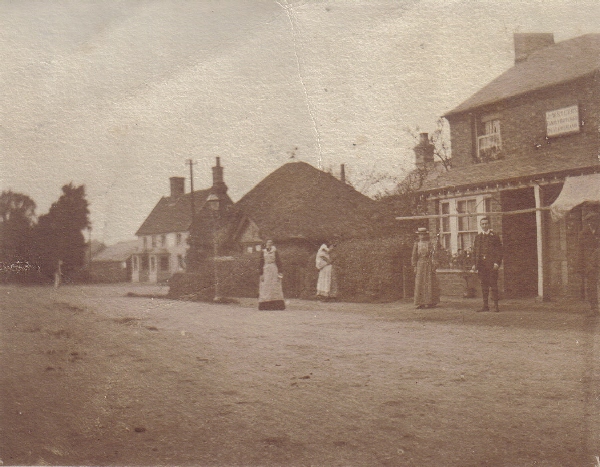
Parker again:- “In 1797, Briggens How having died, his widow sold, with other property, “the messuage, yards, gardens and stables in Aspley Guise, formerly known as The Thatched Inn, now The New Inn”. The purchaser was Daniel Shipton, the Rector of Wavendon, who also owned the fields adjoining and running up the Cranfield road. Through marriage into the family the property passed in 1826 to the Orlebars of Crawley House, and in 1839 Robert Shipton Orlebar mortgaged his property with John Green, the Woburn lawyer (who held mortgages all over the district), but in 1841, Orlebar sold his land to Sir Henry Hoare of Wavendon House.”
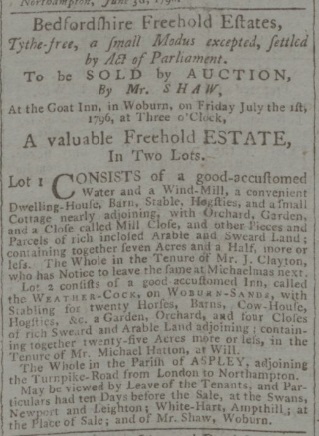
Although the names Thatched Inn and New Inn are being used in deeds of 1797, this auction advert from the Northampton Mercury, of 4th June 1796, used the name Weathercock:
“Bedfordshire Freehold Estates, Tythe-free, a small Modus excepted, settled by an Act of Parliament. To be sold by auction By Mr. Shaw at the Goat Inn, in Woburn, on Friday July the 1st 1796 at three o’clock, a Valuable Freehold Estate in two Lots.
Lot 1. Consists of a good accustomed water and windmill, a convenient dwelling house, barn, stable, hogsties and a small cottage nearby adjoining, with orchard, garden and close called Mill Close, and other pieces and parcels of rich inclosed arable and sweard land, containing together seven acres and a half, more or less. The whole in the tenure of Mr J. Clayton, who has notice to leave the same at Michaelmas next.
Lot 2. Consists of a good accustomed inn, called The Weathercock, on Woburn Sands, with stabling for twenty horses, barns, cow house, hogsties and co., a garden, orchard and four closes of rich sweard and arable land adjoining; containing together twenty five acres more or less, in the tenure of Mr Michael Hatton, at will.
The whole in the parish of Aspley, adjoining to the Turnpike Road from London To Northampton. May be viewed by leave of the tenants, and particulars had ten days before the sale, at the Swans, Newport and Leighton; White Hart, Ampthill; at place of sale; and Mr Shaw at Woburn.”
Parker:- “The Hoare family had been building up its estate from the early days of the century, but it was only now that they bought land from the railway to the top of Weathercock lane, and covering the present Golf course.
The name “New Inn” seems to have been used until the end of the eighteenth and “Weathercock” does not appear in the deeds until the sale to Hoare. It is referred to as The Weathercock in the Wavendon Enclosure Award of 1791. In the sale of nearby property at the apex of Station Road and Weathercock Lane, dated 1812, the description includes “on which stands the sign of the Weathercock”. The sign was evidently placed there, on the other side of the road, so that it could more easily be seen. There were no buildings between the two roads at that time.”
From the Northampton Mercury of 16th September, 1815: “Woburn Sands Statute, commonly called Hogstie End, will be held at Mr. Hutton’s the Weathercock Inn on Wednesday the 20th of September instant. Dinner at one o’clock”
With the Statute Hiring Fairs taking place, as well as some other land auctions I have seen adverts for, they must have been important to offer good food to their customers. From Northampton Mercury, 9th May 1818:
“Cook Wanted, a good plain COOK, who can Bake, and Manage small Dairy. A good Character will required. Enquire Mrs. Hutton the Weather Cock, Hogstye End, near Woburn.”
Parker:- “The licence holders are rarely mentioned in the deeds. In 1758 there was Ralph French. (In 1738 Ralph French owned the lime kilns at Longslade). In 1763 the tenant was Thomas Smith, and the next reference is in 1841 when it was James Hutton, who farmed from the premises much of the surrounding land. The Register of Ale-houses of 1822 to 1829 gives Elizabeth Hutton as the holder. Then she died, and although I think the inn stayed in the family, much of her belongings were sold at auction.”
James had probably inherited it from his parents, as a Michael Hutton had left “the Weathercock public house at Hogstyend” to his wife Elizabeth and un-named children in his will of 1808, although I do not know what year Michael died.

Elizabeth continued to run the inn with assisatnce from her family. From the Northampton Mercury, 19th September, 1829:
“Mrs. ELIZABETH HUTTON, deceased. ALL Persons in any Way indebted to the Estate of Mrs. ELIZABETH HUTTON, late of the Weathercock Inn, WOBURN SANDS, in the county of Bedford, deceased, are desired to pay their respective Debts to Miss Susanna Hutton, of the Weathercock Inn, Woburn Sands aforesaid (the Administratrix), or at my Office, within one Month from this Date: And all Persons having Demands on the said Estate are requested to send Particulars thereof to the said Susanna Hutton, or to me, within the Time aforesaid. By Order the Administratrix, JOHN GREEN, her Solicitor. Woburn, 16th Sept. 1829.”
…and Northampton Mercury 10th October 1829:
“To be sold by Auction by Andrew Gardner on Tuesday 13th Day of October 1829. The useful household furniture, brewing utensils and casks, farming and dairy stock, implements, hay, corn and other effects, on the premises of the late Mrs Hutton, the sign of The Weathercock Inn, Woburn Sands, Bed; comprising four-post, tent and half tester bedsteads, with printed cotton-check furnitures, feather beds, mattresses, blankets, quilts, counterpanes, dressing tables, ditto glasses, night conveniences, painted wash-hand tables, Windsor and other chairs, dining tables, round ditto, glass and earthenware, bed and table linen, corner cupboard, mahogany bureau, kitchen furniture in general, 30 hour clock and case, brewing copper, washing ditto, 14 bushel mash vat, cooler, working and other tubs, four two hogshead sweet iron bound casks, hogshead and half hogshead ditto with a variety of other effects. Farming stock and co: Two useful draft mares, one exceedingly good Hackney, two dairy cows, ten pigs, one in-pig sow, two broad wheel carts, ploughs, harrows, roll, horse harness, barn tackle, hovel frame, ladders, &c.; about thirty tons of well gotten hay, in three stacks, stump of old hay, about 16 quarters of oats, in the straw, eight loads of wheat; in sacks, &c &c. N.B. Sale to begin precisely at eleven o’clock in the morning, on account of the number of lots.”
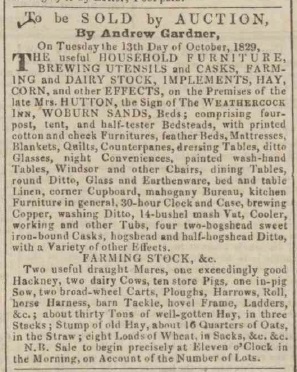
That sale was of the contents of the inn, not the building itself, as that still belonged to the Hoare family of Wavendon. However, the Hoares attempted to sell in 1838, with the Huttons were still in residence. The Northampton Mercury, 1st September 1838:
“Old-established INN and FARM. ASPLEY GUISE, Beds, and WAVENDON, Bucks. TO BE SOLD BY AUCTION, By J. S. DEVEY, On Friday the 21st of September, 1838. at the George Hotel, Woburn, Beds, at Five o’clock in the Afternoon, THE WEATHERCOCK INN, at Woburn Sands, in the parish of Aspley Guise, with spacious yard and convenient outbuildings, and small desirable FARM adjoining, containing Sixty-eight Acres, within the Parishes of Aspley Guise and Wavendon, all lying within a ring fence. The House is eligibly situated for business, on the Manchester road, about forty-four miles from London, two miles from Woburn, and seven from Newport Pagnel. The Inn and Farm are the occupation of Mr. James Hutton, as yearly tenant. May be viewed on application him, and further information obtained from Mr. Green, Solicitor, or from the Auctioneer, both of Woburn. Printed particulars may be had ten days before the Sale on application as above, also at the Offices of Messrs. Keene and Wright, Solicitors, 16, Furnivals Inn, London; and at the Swan. Newport, Bedford, and Leighton; White Hart, Ampthill; Sugar Loaf, Dunstable and the Angel, Northampton.”
.. but it could not have reached the reserve, and the Huttons continued at the inn, as this from the Northampton Mercury, 18th July 1840 shows:
“Stealing a Gosling at Wavendon. Joseph Emerton, and John Smith, were charged with having, on the 30th June last, stolen one gosling, the property of William Yardley, of Wavendon. Frederick Hutton: On the last day of June 1st was repairing the roof of the Weathercock Public-house. I saw the prisoner Emerton with a gosling, he was going down the turnpike road. He was two hundred yards from me, but knew him, having seen him once or twice before. When he had got quarter of mile, he found the other prisoner, who was driving a cart. They ran on each side the horse, urging its speed. I saw the prisoner Emerton run forward, and turn down a corner. I pursued them, and brought Emerton back. He afterwards took me the spot where he had concealed the gosling, and I saw it in a sack. The gosling was produced, and the prosecutor identified it. His lordship told the jury that the only evidence was against Emerton. Verdict, Emerton, Guilty. Smith, Acquitted. Six calendar month’s imprisonment, and hard labour.”
..but by 29th August, James Hutton himself was on the wrong side of the law:
“Woburn Petty Sessions Present Revs James Reed, E. O. Smith, and Major Gilpin. James Hutton was charged by Elizabeth Elstow, hawker of millinery, from Northampton, with assaulting her on the 12th of August. Complainant stated that on the day in question, shewent into the Weathercock Public House, at Aspley Guise, kept by the defendant. She asked for half-a-pint of porter. James Hutton was sitting in his chimney corner very tipsy, he used a great deal of abusive language, took up the kitchen poker, and attempted to strike her. Before he could do so, the servant girl took it from him. Complainant never had a dispute with him before. People in the house were disgusted with his language that they left it. Hutton, in his defence, stated that when complainant came into his house she was very chatty. He told her he knew her business, upon which the complainant doubled her fists, and said she would knock his teeth down his throat. On her coming towards him he took up the poker, and said if she did, he would knock her head off. Mary Massey, the servant was called, but the bench did not consider her testimony worth much, as she contradicted herself in one or two particulars and Hutton was convicted in the penalty of 3s. and 12s, 6d. costs.”
The connection of Huttons and the inn finally comes to a close in 1846, and it would seem badly, as there was a sale of their goods to raise money for their creditors. The Northampton Mercury 19th September:
“Under an Assignment for the Benefit of Creditors. TO BE SOLD BY AUCTION, By F. WHITLOCK, On Monday, September 28, 1846, at Ten o’clock, on the premises, the property of Mr. J. Hutton, Weathercock Inn, ASPLEY GUISE, Beds, THE whole of the neat and useful HOUSEHOLD FURNITURE and Fixtures, three useful Cart HORSES quantity of AGRICULTURAL IMPLEMENTS, and numerous other Effects.”
At the end of November 1846, the licence was transferred to Mr Walter Bailey, but his father, Robert, seems to have been the one who ran the inn. Robert farmed much the same area as Hutton, and his son, Walter, also farmed the land, but did not live at The Weathercock. Parker says Walter lived at the Mill house until about 1922, when he built himself a house in Station road. I could only find one news story about the Baileys time at the inn. From the Northampton Mercury, 1st February 1890:
“WOBURN SANDS. Row at the Weathercock. For kicking disturbance and refusing to leave the Weathercock on the 21st ult., Emily Cox (48) and Louisa Davies (38) were (before Mr. Charles Pole Stuart, Mr. B. B. Drymond, and Colonel Unwin) fined 5s. each and costs or 14 days.”
Again, the inn stayed in one family for a long period, until eventually after 48 years, the Luton Times and Advertiser of 7th December, 1894, reported that the Licence of The Weathercock “..at Aspley Guise”, had transfered from Robert Bailey to Alfred Burbidge, late of Bedford. This means the inn had been run only by the Hutton and Bailey families for 102 years. The inn had been advertised as being available in the Beds Times of 6th October, stating: “To Let, the Weathercock Inn”, Woburn Sands, with Outbuildings and three acres Grass. Full License. Apply Newland and Nash, Lurke Street Brewery Bedford.”
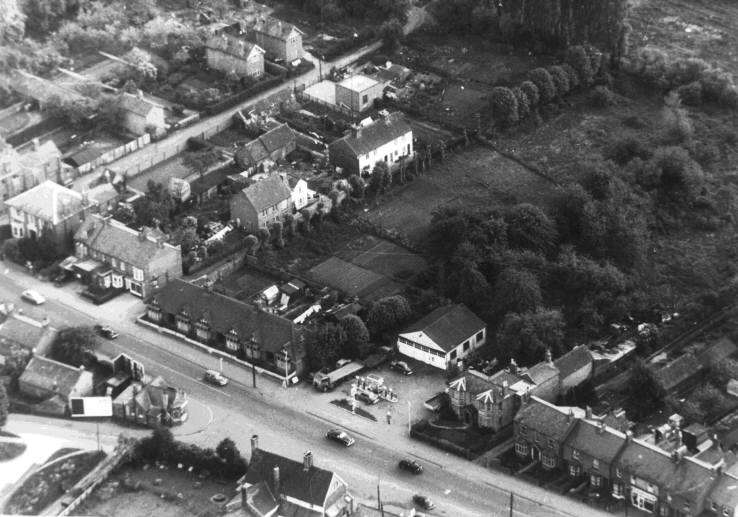
The Hoare family tried again to sell their public houses on 21st October 1902, when they auctioned the Leathern Bottell at Wavendon and the Weathercock. From the Northampton Mercury, 10th October 1902:
“VERY DESIRABLE FREEHOLD LICENSED PROPERTIES, Situate in the Parishes of ASPLEY and WAVENDON, Beds and Bucks, within a short distance of Woburn Sands Station. MESSRS. STAFFORD and ROGERS, LTD., have received instructions TO SELL BY AUCTION, At the Lion Hotel, Bedford, on Friday, Oct. 24th, 1902, at Six o’clock in the Evening punctually, TWO Old-established Fully-licensed PUBLIC HOUSES, one of which is distinguished as “THE WEATHER COCK,” and the other is known as THE OLD LEATHERN BOTTEL.” Possession can be given at Christmas next. Particulars of Sale may be obtained of Messrs Longboume, Stevens and Powell, Solicitors, 7, Lincoln’s Inn Fields, London, W.C.: and of the Auctioneers, 83, High-street, Bedford.”
The Weathercock Inn was purchased by brewers Newland & Nash, of Bedford, who had already leased the inn from the Hoares since at least 1894. George Hensman Archer became landlord in 1909, but his youngest daughter Christobel, died in March 1910, aged 18 years old, and he left the next year. He had also had a soft drinks firm in Fenny Stratford and bottles bearing his name can still be found.
They were advertising for a new tenant again in a May 1914 Beds Times newspaper, but this report comes from the Luton Times, of 3rd July 1914:
“Application of Mr Newton of Bedford for the licence of the Weathercock at Woburn Sands to be temporarily transferred from Joseph Tompkins to Samuel William Hawkes was granted.”
Parker:- “So far as the building is concerned it is interesting to know that it started with a thatched roof, but like many of its contemporaries, the thatch was replaced by tiles, no doubt for the sake of economy. The beer cellar was drained through (or under) the farm buildings and across the meadow land “Swallow Furlong” into the roadside ditch, discharging somewhere near the turning of the old road to Cranfield. An alternation in the building eventually brought an advantage certainly not thought of at the time. At some period bay windows were added to the front, and as the county boundary ran along the face of the house, the bays stood in Bucks. When electricity was brought to Woburn Sands in 1928, the mains were laid down the old turnpike road, past the Inn, but licensee, Teddy Martin, was told he could not take current from them, as his house was in Beds. Electricity did not come from Bedford until two years later, and later still to the bottom of Weathercock Lane. The problem was solved however by taking the Bucks cable into a bay, where the Company’s meter was fixed in its own county; they were not concerned with what happened thereafter, so the wiring of the house in Beds was connected to the main in Bucks, and The Weathercock and its occupants were …de-lighted.”
I had thought perhaps this was a tall local tale, until I found this in the 19th March 1926 Beds Times:
“A fatal accident took place on Sunday at a spot four yards within the Bucks police area. The inquest was the Weathercock Inn. Woburn Sands, the bay windows of which are in Bucks and the remainder in Bedfordshire.”
Another local news report gives the name of Basil George Martin as landlord, when he was sued by a motorcyclist after a collision near Battlesden, as reported in a June 1926 Beds Times.
Since then, the inn has been transferred through Wells and Winch of Biggleswade, to successors, Greene King, which it remains up to the present time.
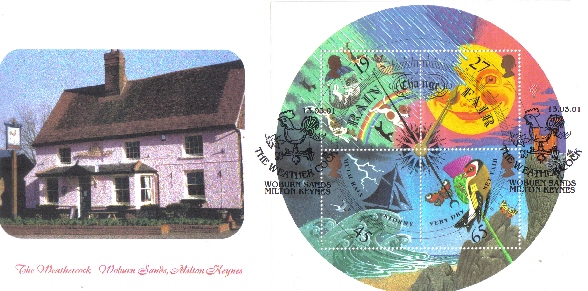
The story of the inn being in two counties has also been used by local musician Graeme Meek, who recorded “More Time, Gentlemen, Please” in 2006, a folk song about the drinkers moving to a different room of the inn when time was called, as the bar in one county had longer opening hours than the bar in the other!
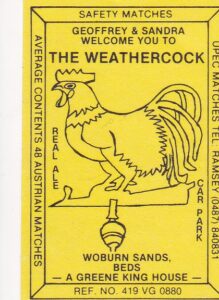
One of the Fir Tree regulars in the 1970’s – 1990’s was Charlie Cole. He was an ex-Naval Stoker, who had once run the Weathercock, and his favourite story about the pub was how he charged extra for ice and lemon in drinks as he thought it was “poncey” and meant he had to go to the kitchen to fetch them!
To this research I can add Bedfordshire and Luton Archives compiled list of known licensees, to which I have added some others from other sources. Please note that this is not a complete list.
1758: Ralph French
1763: Thomas Smith
1785 Mr Price
1792 Mr Hatton
1796-1808: Michael Hutton
1822-1829: Elizabeth Hutton
1838-1841: James Hutton
1846-1894: Walter Bailey, then father Robert Bailey
1894-1897: Alfred Burbidge
1897-1905: Frederick Jacob Roberts
1905-1909: Herbert Dudley Frederick
1909-1911: George Hensman Archer
1911-1914: Joseph Tompkins
1914-1915: Samuel William Hawkes
1915-1947: Edwin (Teddy) Thomas John Martin (a.k.a Basil George Martin?)
1947-1953: Leslie Harold Blanshard
????: Charles Cole
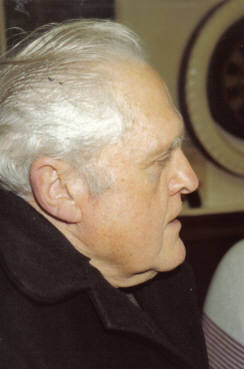
Page last updated Apr. 2023.
